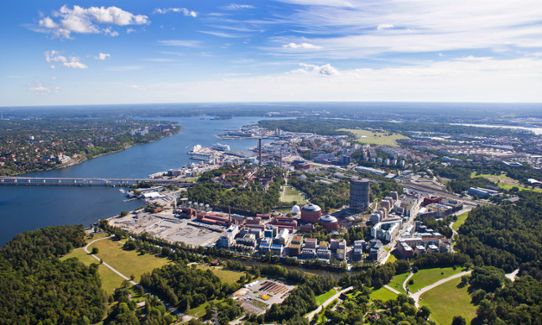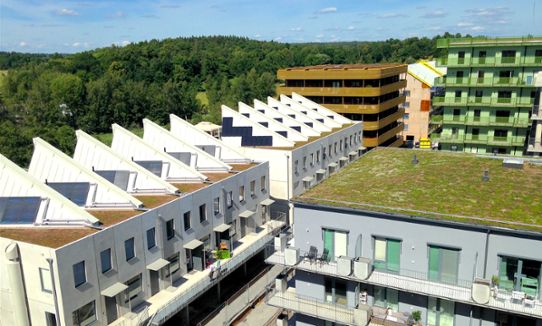The climate change that the climate scenarios have indicated for Stockholm County in the future include more rainfall and clouds, as well as higher temperatures, longer and more intense heat waves, and drier summers. Many of the consequences of these climate changes can be mitigated with vegetation and water structures, via their control of flows and temperature regulating capabilities.
Greenery and climate adaptation in compact cities
Along with urban densification when cities are densified, it is often nature spaces near urban areas that are developed, which means that these green spaces decrease in size or disappear entirely. Greenery and water surfaces in the city environment contribute with so many benefits: they provide an attractive appearance, they can be used for recreational activities and they contribute to increasing biodiversity, among other useful benefits. They also reduce the city’s vulnerability to the adverse impacts of the climate changes.
The Green Area Factor in the Stockholm Royal Seaport district
The Green Area Factor is a planning tool that is used to create greener neighbourhoods in the city. This means that a certain portion of the plot of land must consist of vegetation and/or a water surface. The green area factor which was developed for Norra Djurgårdsstaden has three primary objectives: promotion of biodiversity, bringing social values into the public garden environment, and climate adaptation.

The green area factor means that the planning of the green areas is integrated into the work from the very beginning, as it must be presented in the planning documents. This results in that the landscape architect’s work comes in in the process earlier than usual and a closer cooperation with the building architects occurs.
Four developers collaborated on common ground
The Green Area Factor is calculated per district, and if more than one developer has received land allocations/ground permits in the same district, they are obligated to work together relating to how to attain the goals for the Green Area Factor there.

In the Stora Sjöfall neighbourhood in Norra Djurgårdsstaden, four developers jointly collaborated: Wallenstam, SSM, Bonava and Viktor Hansson. They jointly retained the landscape architect URBIO, which depicted the planned courtyard area, and calculated the green area factor for the plot. An external project manager was brought into the project in order to facilitate the collaborative process between the four developers.
Challenges and Achievements
One of the challenges of working with the tool was to agree upon proper solutions for attaining the desired green area factor while meeting other requirements, such as water management and handicap accessibility, and related matters. In addition, the garden should be designed and formed in such a manner so that it became a pleasant residential environment and the that allocated funds for the project would be sufficient. The design of the garden was also influenced by the underground parking garage. There are certain unavoidable restrictions associated with planting vegetation on top of a sub-structure.
The parties involved took a positive view in regards to the green area factor, even though in some cases it meant changes in their work processes. The mathematical nature made the tool easy to relate to. In the end however, the green area factor yielded elaborate and lush green gardens that were appreciated by the residents.
More examples of climate adaptation
This is one of many examples of climate adaptation. There are more in the collection of ideas being built up by the Swedish National Knowledge Centre for Climate Change Adaptation at the Swedish Meteorological and Hydrological Institute (SMHI). The collection of examples has the aim of sharing experiences and providing ideas to everyone who works with climate adaptation. Examples describe concrete measures and challenges in several subject areas. They show how different actors have worked to adapt their activities to the climate changes that are already being noticed today and those that we cannot prevent in the future.